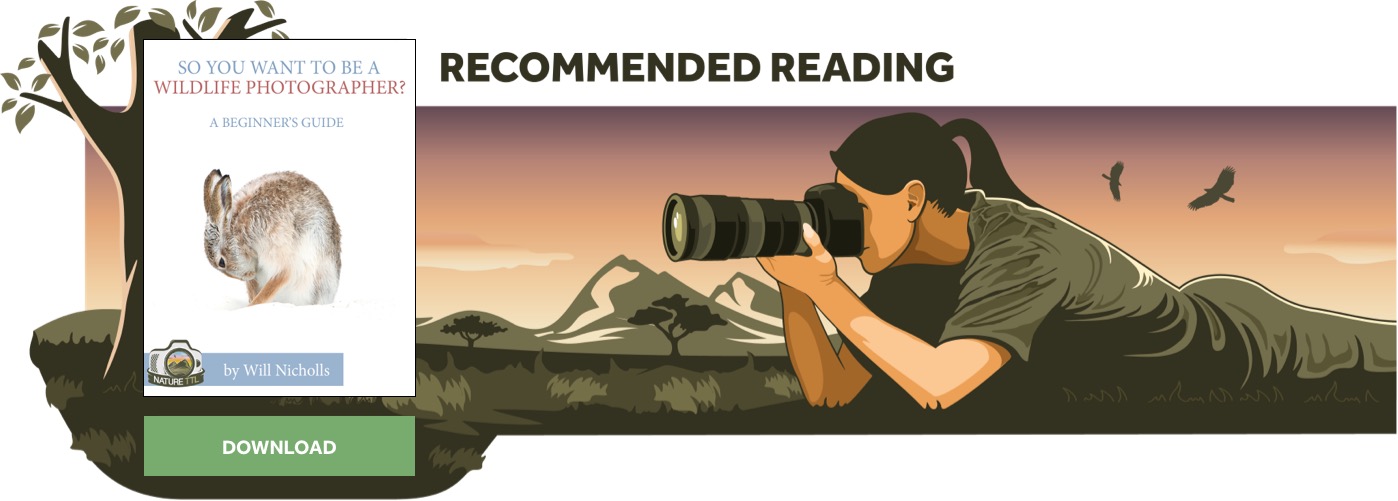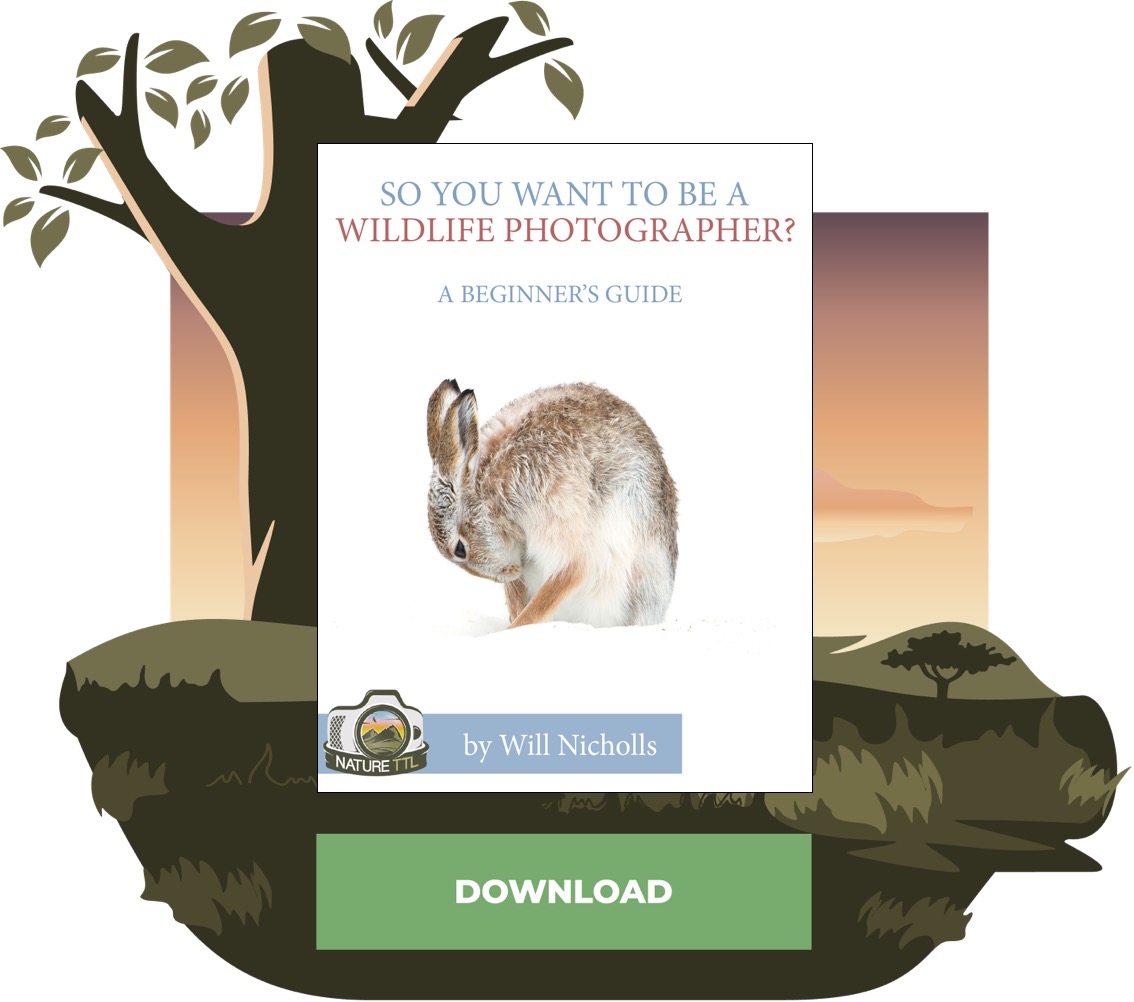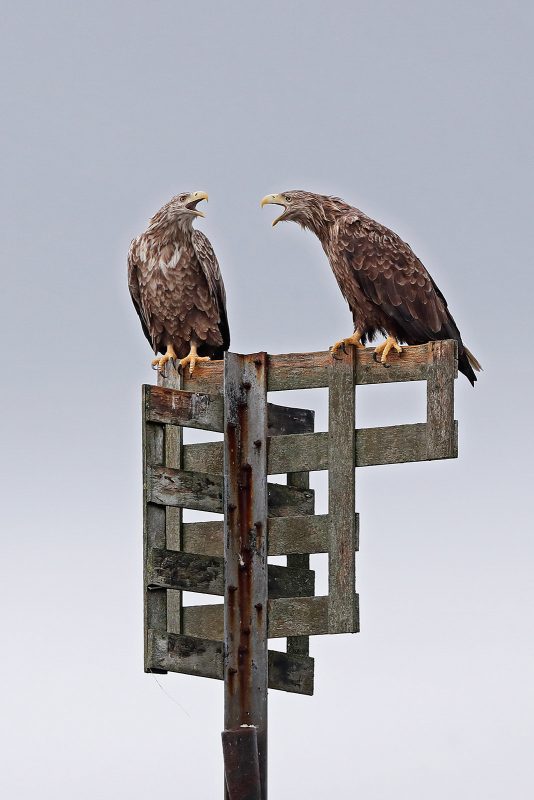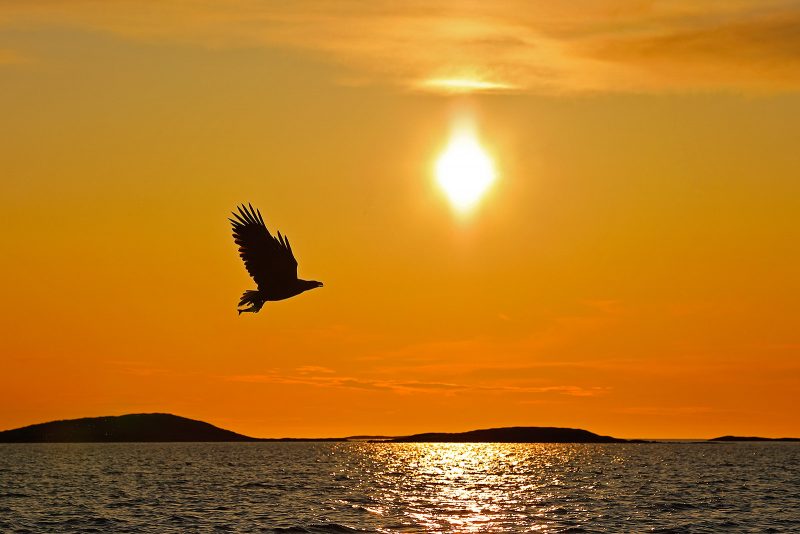How to Photograph Sea Eagles: Locations and Techniques

Sea eagles, also known as white-tailed eagles, are the largest bird of prey in the UK. With a wingspan of around 2.5 metres and huge stature, they are truly an amazing sight. You can easily see where their nickname of “flying barn-doors” comes from.
Having gone extinct in the early 1900s, they were successfully reintroduced to Rum in 1975, with some more in Wester Ross between 1993 and 1998. More recent reintroductions have taken place on the east coast of Scotland and, most recently, in the Isle of Wight.


They are now a welcome and not uncommon sight to see in the Highlands, particularly over on the west coast and the western isles. Mull especially is well known for its resident sea eagles and currently has around 20 breeding pairs.

My first encounters with sea eagles
It was back in the early 90s that I had my first encounter with these huge, impressive birds. Along with a couple of colleagues (Pete Cairns and Mark Hamblin), we chartered a small fishing boat in Portree in Skye that we had heard about.
Apparently, the fisherman could entice the local sea eagle pair nearer to his boat by throwing in some fish that the birds would then swoop down to catch. With only one way to find out, we embarked on this little trip full of anticipation.
As the boat approached the steep cliffs, sure enough in the distance you could just make out the unmistakable shape and colour of a sea eagle perched on a rock. A few minutes later it was airborne and heading towards the boat. Before we could catch our breath, it was circling above us.
Our cameras ready, the boatman flung the fish as far as he could from the boat. Instantly the bird spotted it, tilted to the side, folded its wings slightly, and dived.
I am sure you could have heard our hearts pounding back in Portree. It was pretty frantic trying to track the bird down and keep it in focus as it swooped for the fish. In a few seconds, it had scooped up the fish and was heading back to the cliff.
There was no chance to preview images on this occasion – this was still in the days of film and 36 exposures at a time. I think I used most of the roll on that one dive, and now it would be a week before we could see our results.

Where to photograph sea eagles
1. The Isle of Mull
Fast-forward a decade and, with continued successful breeding, the sea eagles have increased and colonised more nesting sites in their existing areas and also spread further into new surrounding regions. With this welcome advance, it brought more opportunities and possibilities to see and photograph these colossal birds.
One notable new venture is on the Isle of Mull by Martin Kievers (Mull Charters). In principle, it was the same as the fisherman on Skye all those years ago, but now with more birds and a dedicated daily focus on them. It was not just one chance like my first go; now several dives on each outing were readily achievable.

From leaving Ulva pier, it’s surprising how quickly the first bird will come into view. As the bird draws nearer, again that feeling of eager anticipation of what’s to come runs through you. I have lost count of the number of dives I have photographed on Martin’s boat over many years and that same thrill still stirs to this day.
2. Flatanger, Norway with the Eagle Man
For the ultimate sea eagle experience, you will have to venture a bit further afield from the glorious sea lochs of Mull, to the fjords of Norway.
Flatanger is the realm of the sea eagle and home to Ole Martin Dahle known as the “Eagle Man”. Once you have met him and been out with Ole, you will know why he is known by that name.
I first heard of Ole nearly twenty years ago when Pete and Mark brought my attention to this man who was starting some very exciting things in Norway with eagles and other wildlife. Since these beginnings, Ole has now gained legendary status for his amazing sea eagle safaris.

It took me far too long to visit Ole and his eagles, but eventually in 2019 I got my chance. Of course, I went with many friends and colleagues’ stories ringing in my ears of how amazing it is. I felt my own expectations growing: could it possible live up to so much hype?
On the first morning as we loaded the boat, Ole looks out into the bay and says, “look, they are waiting.” Dubiously, I scan around the harbour bay and sure enough not 300 metres out, sitting on a marker pole, is a pair of white-tailed sea eagles.
Already I get all the hype. As our boat moves out there are plenty of gulls following who, by the way, are key here and back home on Mull, as their presence helps bring in the eagles.
A few short minutes and we slowly approach the pair sitting on the pole. Side by side they perch and, as they call at each other, I take my first few images of Norwegian sea eagles.
As we move away from the pole, the birds follow and circle overhead in anticipation. Ole throws out the first fish to what would become a familiar expression over the coming days: “fish is out,” closely followed by “eagle is coming down.”
By the end of that first morning, I stopped counting after 20 dives. I think it was 38 in total that first morning. Over that evening and the next three days, the same pattern remained – possibly with even more dives on some outings. It is not just all about the impressive quantity of dives, they are but a part of many special aspects to this trip and place.
Flatanger (meaning flat fjord) itself is a stunningly beautiful place. Even if you saw no eagles it would still be a joy to have a boat trip round the many islets and skerries that are scattered around this rugged archipelago.
Each of the many sea eagle territories offers a different surrounding and backdrop. In turn, these same locations, along with Ole’s knowledge of where to be at the right time, means any lighting conditions are maximised.
Backlit sea eagles in Norway
Sea eagles backlit have always been on my bucket list and on a couple of outings we were blessed with perfect conditions. It is not every territory that works for these specialist light occasions, but with Ole’s knowledge he takes us to the perfect location.
Read more: Backlighting in Wildlife Photography: Creative Use of Light
Fish is out and down the eagle comes with a halo of light around its outline. It stands out like a glowing beacon against the dark background. As it strikes the fish, the splash sends thousands of gleaming water droplets upwards, filling the scene. It spirals away with its fish as the last remaining water droplets rain down; a ring of light still clings around the eagle as it disappears into the distance.
I have waited so many years for such a moment, so it was with a nervous disposition that I tentatively viewed my images on the camera’s LCD. Subconsciously, I held my breath as I flicked through the sequence – eventually exhaling with huge satisfaction and relief that I had not messed up a once in a lifetime moment.
Seeing these magnificent eagles in such an impressive place as Flatanger, and witnessing Ole’s love for these birds and his home, gave me priceless memories which in many ways are just as important as the pictures.
Techniques for photographing sea eagles
Technically, for this fast tempo action photography there are a few techniques you can use to help your chances and maximise your hit rate.
1. Setting the exposure
I would suggest, on this occasion, using manual settings as there can be quite a few stops difference between the eagle circling in the sky above and when it drops lower against the hills and water as it dives.
The best way to do this is to take a mid-tone reading from some of the surroundings – like the cliff face or surrounding hills. Set this mid tone exposure and, as long as the light stays constant, your main diving shots should be exposed fine.
There could, however, be a slight trade off as any images taken against a brighter white sky will be underexposed, unless it is a nice blue or darker moody type sky that are closer to a mid-tone colour. When fixing your initial exposure, make sure you get a fast-enough shutter speed to capture the fast action, ideally a minimum off 1/1000th sec, faster if possible.
Read more: Understanding Different Metering Modes
2. Freezing the action
To help achieve a fast enough shutter speed to freeze the action, select a wide f-stop on your lens – say around f/4 to f/5.6 or f/8 at the most. Adjust your ISO higher to help you if the light is marginal. My motto is that it’s better to have a slightly noisy picture than an unsharp, useless one.
One last point – and it may seem obvious – is to check your images on the camera’s LCD as soon as your first dive has passed. This allows you to make any necessary adjustments before the next opportunity arises.
If you are ever lucky enough to get the chance to try some backlit eagles, it is best to underexpose possible by as much as two stops. Try a couple of test shots on the gulls, or even the water itself, to give yourself a starting point.
3. Tracking the bird
Once you have your correct exposure, the next most important technicality is tracking the bird in and through its dive. Of course, you will need your predictive focus tracking set for this: AI Focus on a Canon or AF-C on a Nikon, for example.
How many focus points you choose to highlight is more of a personal choice and depends on what you feel comfortable with. My own preference is mostly just the single point. I find that it is the most accurate and stable point.
My concern with using numerous highlighted points is that they can, on occasions, inadvertently pick up the wing tip instead of the head or body. Also, when the bird is just above the water, sometimes a wave can catch the focus. All of these types of scenarios are more likely with a higher number of focus points activated.
I have found this out to my cost, and find with just the single point the above situations happen a lot less. This ensures that I get more consistent results. I know plenty of folk prefer using multiple points, so I repeat that if it works for you then stick with it.
4. Recommended equipment
Lens wise, I would say ideally a minimum of a 300mm is required. Larger lenses like 500mm and 600mm of course can be also used, but remember you will be handholding as there is no room on the boats for tripods.
Zooms ranging from 100-600mm will also serve the purpose well, and give you welcome flexibility. If you are concerned about handholding, a monopod is the perfect solution and compact enough not to cause issues.
In conclusion
Over the years, I have been fortunate to experience many a wildlife spectacle and hope there will be more to surely come. However, at this moment in time if you want to experience one yourself, and you have not already done so, get in touch with Martin at Mull Charters or Ole in Norway – and there are indeed others who do similar outings.
Photograph Eagles: Search the Nature TTL Hub
You will then see why I, and others, wax so lyrical about these sea eagles. Find them, watch them, photograph them, and absorb yourself in them.
When you do get there, try on at least one occasion not just to look at them through the camera. Take a moment and just watch these immense eagles in their realm – it will be worth it.
















